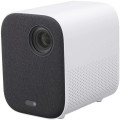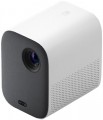Operating system
—
Smart TV (proprietary system). The operating system of the projector is represented by the proprietary software shell of the manufacturer. Usually such operating systems have an attractive and convenient menu, similar to a traditional Smart TV. A proprietary operating system is developed by the manufacturer for the hardware resources of a particular projector model or a whole line. But, as practice shows, compared to the classic Smart TV, the functionality of proprietary system often has significant limitations, and the system itself, in fact, is a stripped-down version of a full-fledged Smart TV.
—
Smart TV (Android AOSP). This type of operating system is a modification of the popular Android OS, mainly notable for being open source. It is a versatile operating system that gives the user much more freedom to create changes and customizations within the system. At the same time, the installation and work stability of certain applications on this platform are not guaranteed, and the overall system management was not specially “tailored” for large screens, which may cause some inconvenience. First of all, such solutions will will generate interest among users who understand the features of the Android OS, like to customize and control everything, and have time for this.
—
Android TV. This type of projector has full-fledged Android TV software, spec
...ially adapted to work on large screens. In accordance with the name, it is a type of Android OS, specially designed for projectors/TVs, etc. In addition to the common features of all “Androids” (such as the ability to install additional applications, including even games), it has a number of special features: optimized interface, integration with smartphones (including the ability to use them as a remote control), voice search, etc. Thanks to this, TVs with this feature are significantly superior in functionality to models with a Smart TV. Of course, a dedicated processor, graphics subsystem and memory are provided for the operation of a multifunctional OS, and the presence of such hardware resources is reflected in the total cost of the projector. Given the same optical design, models with Android TV will cost more than classic projectors with a simple multi-line menu.Lamp power
The power consumption of the backlight lamp installed in the projector.
Theoretically, the more powerful the lamp, the brighter it is. However, this is only true when comparing lamps of the same type (see above); and even in this case, the brightness may also depend on the nuances of the design. Therefore, when evaluating the capabilities of a lamp, it is worth focus not so much on power, but on the directly claimed brightness in lumens (see below).
But what this parameter directly affects is the total power consumption of the projector: the lamp is the most “greedy” component of the device, compared to it, the power consumption of the rest of the electronics is very small. Also note that many powerful lamps have high heat dissipation and require cooling systems, which affects the size and weight of the projector.
Throw distance, min
The closest distance to the screen that the projector can be used on. Typically, this is the minimum distance at which the image from the projector remains in focus.
This parameter is especially important if the device is to be placed at a small distance from the screen (for example, in a cramped room). Some modern projectors are able to work normally at a distance of 10 – 20 cm. Also note that the throw distances are determined primarily by the lens, and if the initial range of these distances does not suit you, perhaps the situation can be solved by replacing the optics.
Throw distance, max
The farthest distance from the screen that the projector can be used on. This is the maximum distance at which the image remains in focus and maintains acceptable brightness — at least enough for viewing in a darkened room on a high-quality screen.
It is necessary to choose according to this parameter taking into account the expected operating conditions and the distances to be dealt with. At the same time, it's ok to have a certain margin for the maximum distance — since, as already mentioned, it is usually indicated for an perfect screen and a darkened room, and such conditions are not always available. Also note that although the throw distances depend on the lens, not every projector with an interchangeable lens allows the installation of more "long-range" optics than the standard one — the device may simply not have enough brightness for an increased distance.
Image size
Size of the image projected by the projector. Usually, it is indicated as a range — from the smallest, at the minimum throw distance, to the largest, at the maximum. About throw distances, see above; here it is worth saying that the choice of diagonal size depends both on the distance between the screen and the audience, and on the format of the projector. For example, to watch a video, the best option is the situation when the distance from the viewer to the image corresponds to 3-4 diagonals, and a relatively large picture can be useful for working with presentations. More detailed recommendations for different situations can be found in special sources; here we only recall that the image must fit on the screen used with the projector.
Keystone correction (vert), ±
Vertical keystone correction allows you to align the image when the projection ray is shifted from the centre of the screen in a vertical plane. If the projector is suspended from the ceiling and shines from top to bottom, a vertical keystone occurs. And the function of vertical keystone correction allows you to align the picture.
In most cases, projectors can only correct vertical keystone. But the keystone can also be horizontal if the projection ray is offset from the centre of the screen in the horizontal plane. Advanced models are often equipped with an auto keystone correction feature (see the relevant paragraph). In this case, the keystone is aligned in a fully automatic mode, without user participation.
Wi-Fi
Wi-Fi standard supported by the projector.
Wi-Fi is known mainly as a way to connect wirelessly to the Internet and local networks. In addition, since relatively recently, this technology has also been used for direct connection between wireless devices. Accordingly, the methods of using Wi-Fi in projectors can also be different. Thus, some models are able to connect to local networks to work with content via DLNA (see above); in others, such a connection is used for control from a computer or other network device; in others, a “remote control” such as a smartphone or tablet can connect directly via Wi-Fi.
As for Wi-Fi versions, the most popular options in modern technology -
Wi-Fi 6 (802.11ax),
Wi-Fi 5 (802.11ac) - are quite compatible with each other, and the difference between them in this case is not critical. Therefore, you can not pay special attention to these details when choosing.
There are also
Wi-Fi ready projectors, which do not have Wi-Fi out of the box, but when connected to the appropriate adapter (purchased separately) are capable of wireless connection.
USB 2.0
The number of USB 2.0 ports provided by the projector.
Do not confuse these connectors with USB slave (see "Management ports") — in this case we are talking about
USB ports for various peripherals. Most often, these ports are used for direct playback of content from flash drives and other storages (for example, external HDDs). At the same time, we note that video viewing is not available in some projectors (only photos), in others a very limited set of formats may be supported. However, a direct connection is often more convenient than viewing through a computer or other device. The USB ports can also be used for other purposes, such as updating firmware, transferring files between a flash drive and the projector's built-in storage, or even for keyboards/mouses (in Android devices, see above).
The USB 2.0 standard itself is considered obsolete, but it is quite enough for projectors, and newer peripherals are fully compatible with such connectors. At the same time, you rarely have to connect more than one external device to the projector at a time, so there are few models with more than one USB 2.0.
USB 3.2 gen1 (3.0)
The number of USB 3.2 gen1 ports provided in the projector. Initially, this interface was called USB 3.0, later USB 3.1 gen1.
Anyway USB is the most popular modern interface for connecting various peripherals to a computer — from keyboards, mice and flash drives to very original devices. USB 3.2 gen1 is the successor to the popular USB 2.0, with 10x faster transfer rates (up to 4.8Gbps) and more power. At the same time, peripherals of earlier standards can also be connected to this connector — the main thing is that it has a full-size USB-A plug. As for the number, the more USB ports in the projector, the more devices can be connected to it without using splitters.

